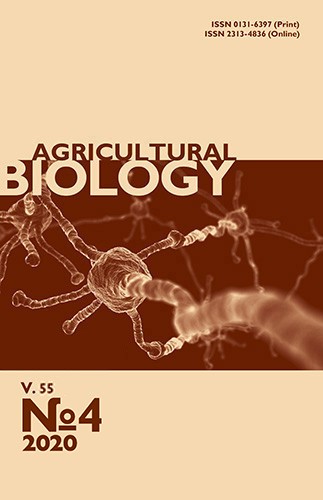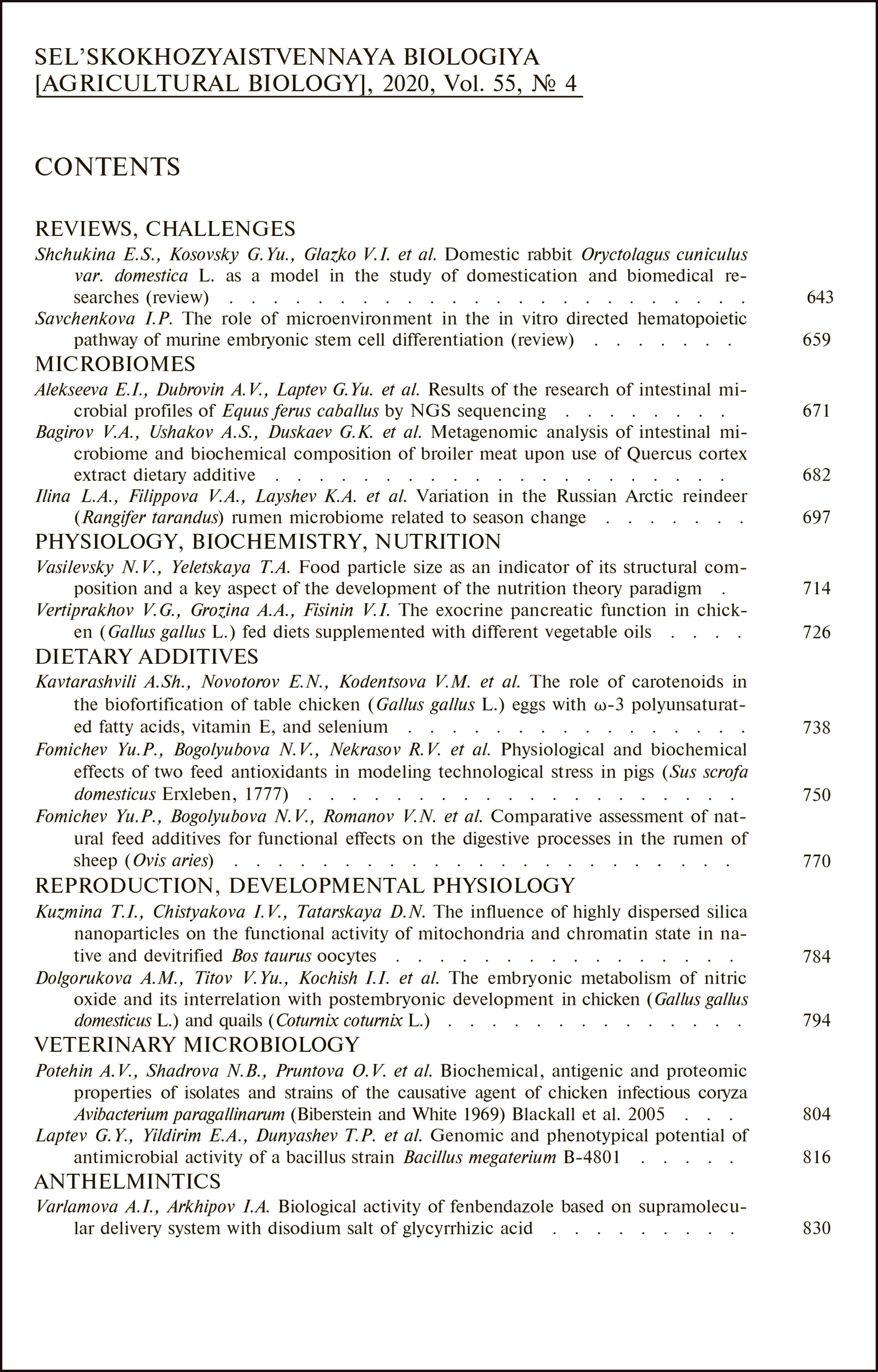doi: 10.15389/agrobiology.2020.4.804eng
UDC: 636.52/.58:619:579.62
BIOCHEMICAL, ANTIGENIC AND PROTEOMIC PROPERTIES OF ISOLATES AND STRAINS OF THE CAUSATIVE AGENT OF CHICKEN INFECTIOUS CORYZA Avibacterium paragallinarum (Biberstein and White 1969) Blackall et al. 2005
А.V. Potehin, N.B. Shadrova, О.V. Pruntova, V.S. Rusaleev, Val.А. Evgrafova
Federal Center for Animal Health Control, FGBU VNIIZZh, mkr. Yurievets, Vladimir, 600901 Russia, e-mail potehin@arriah.ru, shadrova@arriah.ru, pruntova@arriah.ru (corresponding author ✉), rusaleev@arriah.ru, evgrafova@arriah.ru
ORCID:
Potehin A.V. orcid.org/0000-0002-3529-4809
Rusaleev V.S. orcid.org/0000-0002-4972-6326
Shadrova N.B. orcid.org/0000-0001-7510-1269
Evgrafova Val.A. orcid.org/0000-0003-3053-6976
Pruntova O.V. orcid.org/0000-0003-3143-7339
Received September 4, 2019
Infectious coryza (haemophilus infection) of chickens is a disease reported in many countries of the world. In the Russian Federation, there is no information both about the extent of the disease spread across the poultry farms and about the serotype diversity of the agent circulating in the country. The paper for the first time demonstrates biochemical properties and specifies antigenic relatedness of new Avibacterim paragallinarum isolates recovered from chickens with respiratory signs in Russia and in Belarus. The paper also shows results of creation of the Avibacterim paragallinarum subsection in the database of tested microorganisms’ mass-spectra which can be used as reference ones for the identification and protein profiling of the infectious coryza agent strains and isolates. The work aimed to determine biochemical and antigenic properties of A. paragallinarum isolates and to produce the species-specific mass-spectra as a tool for Avibacterim paragallinarum species identification and intraspecies differentiation. A. paragallinarum No. 29545 АТСС (serotype А1) form the collection of the Federal Centre for Animal Health (ARRIAH) served as a reference strain. Thirteen A. paragallinarum isolates were used in the study. The isolates were recovered from the pathological material collected from chickens with respiratory pathology (nasal exudates, contents of infraorbital sinus and conjunctival sac, lung tissues) in 2015. The isolates were inoculated onto Columbia agar supplemented with 5 % defibrinated sheep blood, together with a streak of Staphylococcus epidermidis. Pure cultures of the agent were grown on the serum agar containing NADP at 20 μkg/cm3 and 5 % of horse blood serum. The bacteria were cultured for 24-72 at high CO2 concentration and 37 °С. Bilateral antigenic relatedness of the reference strain АТСС No. 29545 and A. paragallinarum isolates was determined using slide agglutination test (SAT). Hemagglutination activity was assessed using hemagglutination inhibition test (HI). Homogeneity of the tested isolates’ serogroup was confirmed by PCR. Amplified 800 bp DNA fragments were indicative of the presence of serogroup A A. paragallinarum genome, 1000-1100 bp of serogroup В, and 1500-1600 bp of serogroup С. A. paragallinarum identification was performed using MALDI Autoflex III Biotyper mass-spectrometer (Bruker Daltonik GmbH, Germany). The resulted mass-spectra were recorded, processed and analyzed using FlexControl 3.4 software (Bruker Daltonik Gmb», Germany) according to MALDIBiotyper 2.0. UserManual, Version 2.0 SR1, Germany, 2008. Testing of biochemical properties indicated that all 13 isolates of A. paragallinarum form a diverse group. The A. paragallinarum isolates’ growth absolutely depended upon presence of blood serum in the culture medium. Saccharolytic activity of the A. paragallinarum isolates also varied. All isolates and the reference strain can utilize glucose and sucrose, but not lactose, trehalose and galactose. The property also varied for mannitol and mannose. As for antigenic properties, all tested isolates belonged to the same serogroup B that was also confirmed by real-time polymerase chain reaction method. Examination of proteomic properties of A. paragallinarum isolates revealed typical MS peaks, m/z 4768-4770 and 5347-5349, that were similar to those for the reference strain A. paragallinarum ATCC No. 29545. Protein profile mass-spectra were entered into MALDI Autoflex III Biotyper database to improve the reliability of A. paragallinarum species identification. Basing on the examined biochemical, antigenic and proteomic properties, three A. paragallinarum isolates were deposited in the strain collection of the Federal Centre for Animal Health (ARRIAH) as A. paragallinarum strain No. 1818, A. paragallinarum strain No. 5111, and A. paragallinarum strain No. 1116.
Keywords: strain, isolate, Avibacterium paragallinarum, identification, biochemical characterization, antigenic properties, proteomic properties, mass spectrometry, agglutination test, hemagglutination inhibition assay
REFERENCES
- Rozhdestvenskaya T.N., Kononenko E.V., Emel'yanova S.A., Yakovlev S.S., Teimurazov M.G., Svetoch E.A., Tazina O.I., Platonov M.E., Detushev K.V., Khatyushin Yu.I. Ptitsa i ptitseprodukty, 2016, 4: 50-53 (in Russ.).
- Chukiatsiri K., Chotinun S., Chansiripornchai N. An outbreak of Avibacterium paragallinarum serovar B in a Thai layer farm. The Thai Journal of Veterinary Medicine, 2010, 40(4): 441-444.
- Poernomo S., Sutarma S., Rafiee M., Blackall P.J. Characterisation of isolates of Haemophilus para-gallinarum from Indonesia. Australian Veterinary Journal, 2000, 78(11): 759-762 CrossRef
- Akhter S., Ali M., Das P.M., Hossain M.M. Isolation and identification of Avibacterium paragallinarum the causal agent of infectious coryza (IC) from layer chickens in Bangladesh. Journal of the Bangladesh Agricultural University, 2014, 11: 87-96 CrossRef
- Vargas E.S., Terzolo H.R. Haemophillus paragallinarum: etiology of infectious coryza. Veterinaria México, 2004, 35(3): 245-259.
- Byarugaba D.K., Minga U.M., Gwakisa P.S., Katunguka-Rwakishaya E., Bisgaard M., Olsen J.E. Virulence characterization of Avibacterium paragallinarum isolates from Uganda. Avian Pathology, 2007, 36(1): 35-42 CrossRef
- Lizun R.P. Diagnostika gemofileza kur (obzor). Ekologiya i zhivotnyi mir, 2016, 1: 42-49 (in Russ.).
- Lau A.F., Drake S.K., Calhoun L.B., Henderson C.M., Zelazny A.M. Development of a clinically comprehensive database and a simple procedure for identification of molds from solid media by matrix-assisted laser desorption ionization-time of flight mass spectrometry. Journal of Clinical Microbiology, 2013, 51(3): 828-834 CrossRef
- Clark A.E., Kaleta E.J., Arora A., Wolk D.M. Matrix-assisted laser desorption ionization-time of flight mass spectrometry: a fundamental shift in the routine practice of clinical microbiology. Clinical Microbiology Reviews, 2013, 26(3): 547-603 CrossRef
- Chalupová J., Raus M., Sedlářová M., Šebela M. Identification of fungal microorganisms by MALDI-TOF mass spectrometry. Biotechnology Advances, 2014, 32(1): 230-241 CrossRef
- Alshawa K., Beretti J.-L., Lacroix C., Feuihade M., Dauphin B., Quesne G., Hassouni N., Hassif X., Bougnoux M.-E. Successful identification of clinical dermatophyte and Neoscytalidium species by matrix-assisted laser desorption ionization-time of flight mass spectrometry. Journal of Clinical Microbiology, 2012, 50(7): 2277-2281 CrossRef
- Metody obshchei bakteriologii. Tom 1 /Pod redaktsiei F. Gerkhardta, R. Myurrei, R.N. Kostilova, E.V. Nester, V.A. Vud, N.R. Krieg, F.G. Briggs; perevod s angliiskogo pod redaktsiei E.N. Kondrat'evoi, L.V. Kalakutskogo [Methods of general bacteriology. Vol. 1. F. Gerkhardt, R. Myurrei, R.N. Kostilov, E.V. Nester, V.A. Vud, N.R. Krieg, F.G. Briggs (eds.). E.N. Kondrat’eva, L.V. Kalakutskii (translation eds.)]. Moscow, 1983 (in Russ.).
- Page L.A. Haemophilus infections in chickens. I. Characteristics of 12 Haemophilus isolates recovered from diseased chickens. American Journal of Veterinary Research, 1962, 23: 85-95.
- Blackall P.J., Eaves L.E. Serological classification of Australian and South African isolates of Haemophilus paragallinarum. Australian Veterinary Journal, 1988, 65(11): 362-363 CrossRef
- Archetti I., Horsfall F.L. Persistent antigenic variation of influenza A virus after incomplete neutralization in ovo with heterologous immune serum. The Journal of Experimental Medicine, 1950, 92(5): 441-462 CrossRef
- Sakamoto R., Kino Y., Sakaguchi M. Development of a multiplex PCR and PCR-RFLP method for serotyping of Avibacterium paragallinarum. The Journal of Veterinary Medical Science, 2012, 74(2): 271-273 CrossRef
- Patil V.V., Mishra D., Mane D.V. 16S ribosomal RNA sequencing and molecular serotyping of Avibacterium paragallinarum isolated from Indian field conditions. Veterinary World, 2017, 10(8): 1004-1007 CrossRef
- Kumar A., Rawat M., Verma R. Studies on absolute requirement of NAD and reduced oxygen ten-sion for growth of field isolates of Avibacterium paragallinarum of poultry origin. Indian Journal Poultry Science, 2012, 47(1): 90-92.
- Banani M., Pourbakhsh S.A., Khaki P., Goudarzi H., Moazeni-Joula G., Ghodsian N. Isolation, identification and antibiotic sensitivity of Haemophilus paragallinarum isolates from commercial layer flocks affected by infectious coryza. Pajouhesh-Va-Sazandegi, 2007, 19(1): 128-135.
- Patil V.V., Mishra D.N, Mane D.V. Isolation, characterization and serological study of Avibacterium paragallinarum field isolates from Indian poultry. Journal of Animal and Poultry Sciences, 2016, 5(1): 13-20.
- Kaur J., Sharma N.S., Gupta K., Singh A. Epidemiological studies on infectious coryza in chickens in Northern India. Indian Journal of Animal Sciences, 2004, 74(5): 462-465.
- Teimurazov M.G., Platonov M.E., Tazina O.I., Manin T.B. Veterinariya, 2016, 6: 26-29 (in Russ.).
- Eaves L.E., Rogers D.G., Blackall P.J. Comparison of hemagglutinin and agglutinin schemes for the serological classification of Haemophilus paragallinarum and proposal of a new hemagglutinin serovar. Journal of Clinical Microbiology, 1989, 27(7): 1510-1513 CrossRef
- Chen J.H.K., Cheng V.C.C., Wong C.-P., Wong S.C.Y., Yam W.-C., Yuen K.-Y. Rapid differentiation of Haemophilus influenzae and Haemophilus haemolyticus by use of matrix-assisted laser desorption ionization-time of flight mass spectrometry with ClinProTools mass spectrum analysis. Journal of Clinical Microbiology, 2017, 55(9): 2679-2685 CrossRef
- Takeuchi N., Segawa S., Ishiwada N., Ohkusu M., Tsuchida S., Satoh M., Matsushita K., Nomura F. Capsular serotyping of Haemophilus influenzae by using matrix-associated laserdesorption ionization-time of flight massspectrometry. Journal of Infection and Chemotherapy, 2018, 24(7): 510-514 CrossRef












